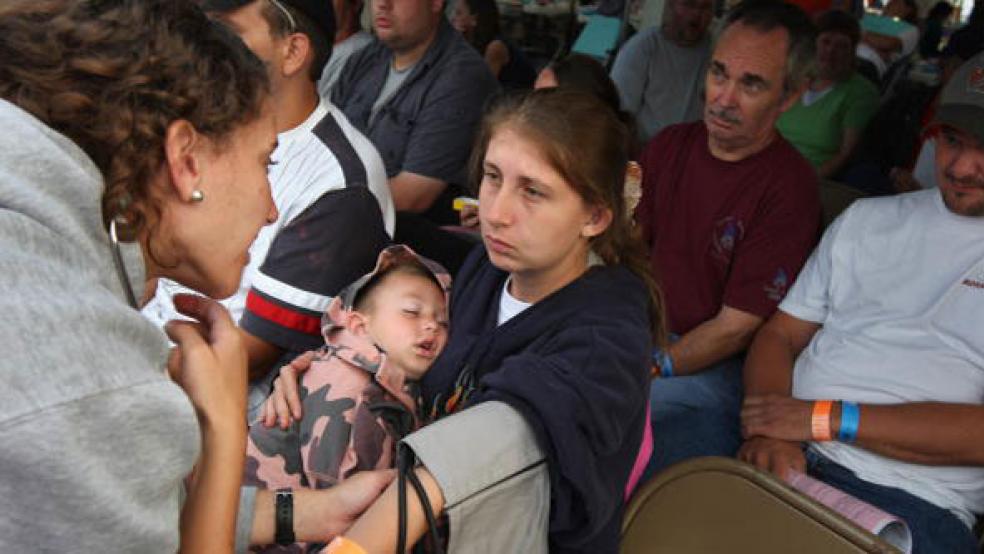Colomba Funes, 48, a full-time housekeeper in Arlington, Va., has been using medical services at the Arlington Free Clinic for more than ten years. Unable to afford health insurance on her low income, she visits the clinic for everything from routine health checkups to treatment for depression. “If I couldn’t come here, I wouldn’t have a place to go,” she says.
Funes is just one of 1,700 patients seen by doctors at the Arlington Free Clinic in the past year alone. Though the clinic recently moved into a new 8,100-square-foot office and employs a full-time staff of 19, it’s been forced to turn patients away because it can’t meet demand. Turns out, this isn’t unusual. In the second half of 2009, the 58 member clinics of the Virginia Association of Free Clinics have had to turn away 1,300 eligible patients per month, says Lou Markwith, executive director of the association, a nonprofit membership group dedicated to providing training, research and resource development to Virginia’s free clinics.
Until health care reform goes into effect in 2014, more than 46 million Americans remain uninsured and are ineligible for Medicaid. In today’s economy, many have made use of the free community-based health care clinics for everything from basic care to chronic care. “They make a real difference for the patients they see,” said Alwyn Cassil, public affairs officer at the Center for Studying Health System Change. “Given the large number of uninsured, it’s like putting out a five-alarm blaze with a garden hose.”
As private organizations, free clinics are not supported by the federal government, although many have received stimulus funding from the 2009 American Recovery and Reinvestment Act (ARRA) to expand over the next 10 years. Still, relying on state funding and private donations to keep going may not be enough, according to a January report by the Center for Studying Health System Change.
The National Association of Free Clinics (NAFC), an organization dedicated to supporting the free clinics, says the number of patients doubled over the past year. Director Nicole Lamoureux estimates they saw four million patients in 2008 and nearly eight million in 2009. Free clinics across the nation are experiencing a 20 to 30 percent year-on-year increase in patients, according to Lamoureux, and that trend is expected to grow by at least a million patients in 2010.
“We’re seeing people who thought they would never be coming here,” Lamoureux says. “They can’t afford the COBRA payments, and they’re now working jobs that don’t offer health insurance. They say that if it weren’t for the free clinics, they’d be going to the ER — or they wouldn’t see a doctor at all.”
For the roughly 83 percent of patients who come from a working household, many working two or three part-time jobs, these free clinics just might be one of America’s best-kept health secrets.

Patients visit a free clinic as often as once a week or as little as once a year, depending on their medical needs, says Pat McDermott, director of development at the Arlington Free Clinic. However, many patients use the free clinics as a primary care provider (there’s no guarantee they’ll see the same doctor).
Like other health care providers, patients can wait up to two or three weeks or longer to see a doctor if their condition isn’t urgent. Twice a month the Arlington Free Clinic, one of the largest in the state, holds a lottery to fill the 40 new patient slots it keeps open, in case current patients drop out of the system because of relocation, inability to meet eligibility requirements or other reasons. On lottery day it’s not uncommon to see patients lined up outside the office, says McDermott.
To be eligible for the lottery, a patient must be a resident of Arlington County, have no health insurance, have an income at or below 200 percent of the poverty level (the equivalent of $19,000 for an individual), and live in the U.S. for at least one year. McDermott estimates 150 people enter the lottery each month, more than double the monthly level from the previous year.
Free clinics in only a few states, including Ohio, West Virginia and Virginia, receive a small amount of state funding. All free clinics in Virginia will receive a portion of the $3.2 million allotted for the 2011 fiscal year, depending on the number of patients. 3 percent of Arlington Free Clinic’s $2 million annual budget is state funded.
To make up the difference, the clinic actively seeks funding from foundations, individuals, businesses, civic associations and churches.
Doing More With Less
Across the nation, clinics have seen donation levels decrease, with the most significant drop in the last 18 months, according to the National Association of Free Clinics. “Free clinics have the amazing ability to do more with less,” says Nicole Lamoureux. “They work very closely with their local community partners to offer services and opportunities to patients.”
“Some free clinics have had to charge or increase the suggested donation from patients to help cover rising costs as funding becomes more strained,” says Laurie Felland, senior researcher at the Center for Studying Health System Change.
In order to meet patient needs, clinics rely heavily on unpaid volunteers to provide service. Carol Ciofalo, M.D., is a retired gynecologist who has lent a hand at the Arlington Free Clinic for six years. “It’s a way to keep up my skills and give back to the community,” says Ciofalo, who offers her services twice a month. Ciofalo joins 567 other medical and nonmedical volunteers at the clinic who offer primary care, specialty care and chronic illness-related treatment. In 2009, patients received over $3.8 million in valued medical services, including dispensing drugs and medicine for a small suggested fee.

It’s uncertain what will happen once health reform is enacted, but the clinics don’t expect to go out of business anytime soon. “We certainly expect that people will support us. They recognize the work we do and the services provided to people who are in unfortunate circumstances,” Markwith says.
Meantime, more free clinics are springing up around the country. The National Association of Free Clinics averages five calls a week from hospitals, doctors’ offices, and retired physicians who express an interest in starting a clinic. Markwith says the growth of clinics in Virginia is significant, and he expects nine new clinics to join the association over the next year.
Dental Care With Teeth
Dental care is one of the most in-demand health services in the U.S. More than 100 million Americans do not have dental insurance, nearly three times those without health insurance, according to a 2006 study by the Kaiser Family Foundation.
Low-cost options for dental care exist. Dental schools offer reduced cost treatment by dental students who are typically third- or fourth-year students overseen by licensed professors and dentists.
For example, Howard University in Washington, D.C., houses one of the oldest clinics in the U.S. and offers a range of dental treatments and oral health care services for adults and children. New patients pay a $100 for an exam and X-ray and are assigned to a dental student who discusses a dental plan for the patient. The American Dental Association has a complete listing of accredited dental education programs in the United States. The American Dental Hygienist Association offers supervised, low-cost preventive dental care as part of training for dental hygienists.
There are also a number of national nonprofit organizations dedicated to providing free dental care. Dentistry from the Heart (DFTH) is an organization that started in Florida in 2001 and has donated more than $5.5 million in free dental care.
States have their own specific low-cost dental options that can be found through such places as the Virginia Health Care Foundation. Free Medical Camps and Free Dental also offer online databases of free or low-fee dental clinics. To find a government-sponsored dental plan that includes Medicaid, CHIP and Medicare, visit DentaQuest. HHS offers a database of federally funded health care clinics in the U.S. where patients pay a sliding-scale fee based on income.


